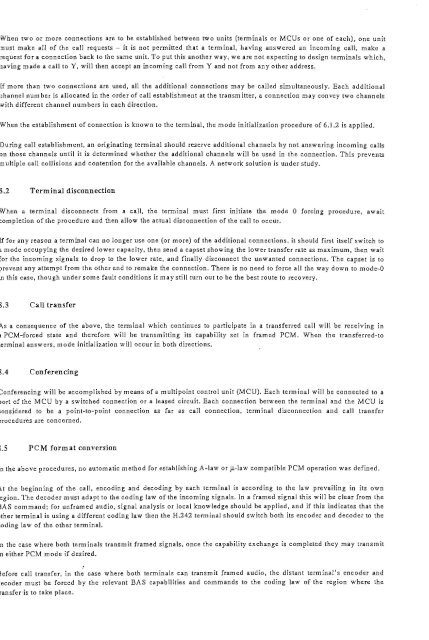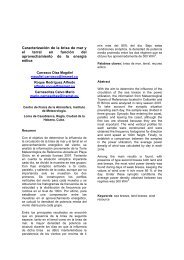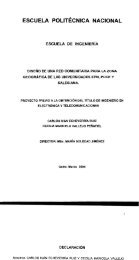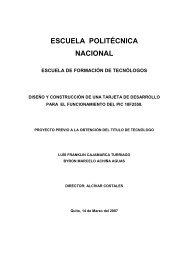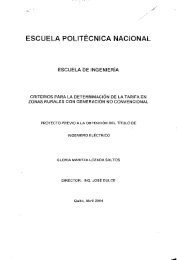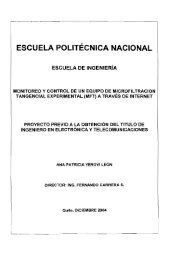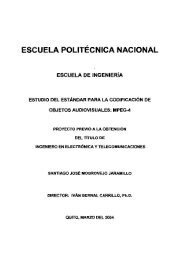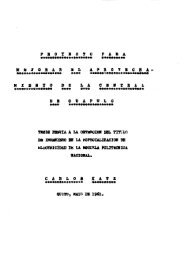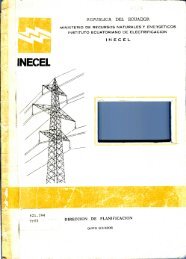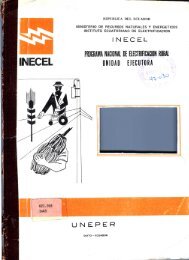Tesis previa a la obtención del Título de Ingeniero en Electrónica y ...
Tesis previa a la obtención del Título de Ingeniero en Electrónica y ...
Tesis previa a la obtención del Título de Ingeniero en Electrónica y ...
Create successful ePaper yourself
Turn your PDF publications into a flip-book with our unique Google optimized e-Paper software.
Wh<strong>en</strong> two or more connections are to be established betwe<strong>en</strong> two units (termináis or MCUs or one of each), one unit<br />
nust make all of the cali requests — it is not permitted that a terminal, havíng answered an íncoming cali, make a<br />
request for a connection back to the same unit, To put this another way, we are not expecting to <strong>de</strong>sign termináis which,<br />
iiaving ma<strong>de</strong> a cali to Y, will th<strong>en</strong> accept an incoming cali from Y and not from any other address.<br />
[f more than two connections are used, all the additional connections may be called simultaneously, Each additional<br />
íhannel number is allocated in the or<strong>de</strong>r of cali establishm<strong>en</strong>t at the transmitter, a connection may convey two channels<br />
tvith differ<strong>en</strong>t channel numbers in each dírection.<br />
Wh<strong>en</strong> the establishm<strong>en</strong>t of connection is known to the terminal, the mo<strong>de</strong> initialization procedure of 6.1,2 is applied.<br />
During cali establishm<strong>en</strong>t, an originating terminal should reserve additional channels by not answering incoming calis<br />
on those channels until it is <strong>de</strong>termined whether the additional channels will be used in the connection. This prev<strong>en</strong>ts<br />
múltiple cali collisions and cont<strong>en</strong>tion for the avai<strong>la</strong>ble channels. A network solution is un<strong>de</strong>rstudy.<br />
5.2 Terminal disconnection<br />
Wh<strong>en</strong> a terminal disconnects from a cali, the terminal must fírst initiate the mo<strong>de</strong> O forcing procedure, await<br />
;ompletion of the procedure and th<strong>en</strong> allow the actual disconnection of the cali to occur.<br />
Ef for any reason a terminal can no longer use one (or more) of the additional connections, it should first itself switch to<br />
i mo<strong>de</strong> occupying the <strong>de</strong>síred lower capacity, th<strong>en</strong> s<strong>en</strong>d a capset showing the lower transfer rate as máximum, th<strong>en</strong> wait<br />
;or the incoming signáis to drop to the lower rate, and finally disconnect the unwanted connections. The capset is to<br />
prev<strong>en</strong>t any attempt from the other <strong>en</strong>d to remake the connection. There ís no need to forcé all the way down to mo<strong>de</strong>-0<br />
n thís case, though un<strong>de</strong>r some fault condilions it may still turn out to be the best route to recovery.<br />
3.3 Cali transfer<br />
\ a consequ<strong>en</strong>ce of the above, the terminal which continúes to particípate in a transferred cali will be receiving ín<br />
i PCM-forced state and therefore will be transmitting its capability sel in framed PCM. Wh<strong>en</strong> the transferred-to<br />
;erminal answers, mo<strong>de</strong> initialization will occur in both directions.<br />
í.4 Confer<strong>en</strong>cing<br />
^onfer<strong>en</strong>cing will be accomplished by means of a multipoint control unit (MCU). Each terminal will be connected to a<br />
>ort of the MCU by a switched connection or a leased círcuit. Each connection betwe<strong>en</strong> the terminal and the MCU ¡s<br />
¡onsi<strong>de</strong>red to be a point-to-point connection as far as cali connection, terminal disconnection and cali transfer<br />
jrocedures are concerned.<br />
5.5 PCM format conversión<br />
n the above procedures, no automatic method for establishing A-<strong>la</strong>w or u,-<strong>la</strong>w compatible PCM operation was <strong>de</strong>fined.<br />
U the beginning of the cali, <strong>en</strong>coding and <strong>de</strong>coding by each terminal is according to the <strong>la</strong>w prevailing in its own<br />
egion. The <strong>de</strong>co<strong>de</strong>r must adapt to the coding <strong>la</strong>w of the incoming signáis. In a framed signal this wilí be clear from the<br />
3AS command; for unframed audio, signal analysis or local knowledge should be applied, and if this indicates that the<br />
ither terminal is using a differ<strong>en</strong>t coding <strong>la</strong>w th<strong>en</strong> the H.242 terminal should switch both its <strong>en</strong>co<strong>de</strong>r and <strong>de</strong>co<strong>de</strong>r to the<br />
¡oding <strong>la</strong>w of the other terminal.<br />
n the case where both termináis transmit framed signáis, once the capability exchange is completed they may transmit<br />
n either PCM mo<strong>de</strong> if <strong>de</strong>sired.<br />
3efore cali transfer, in the case where both termináis can transmit framed audio, the distant termmal's <strong>en</strong>co<strong>de</strong>r and<br />
[eco<strong>de</strong>r must be forced .by the relevant BAS capabüities and commands to the coding <strong>la</strong>w of íhe región where the<br />
ransferis lo take p<strong>la</strong>ce.


